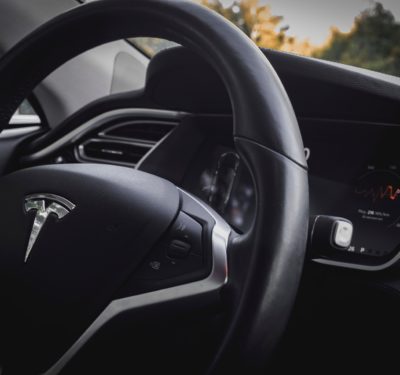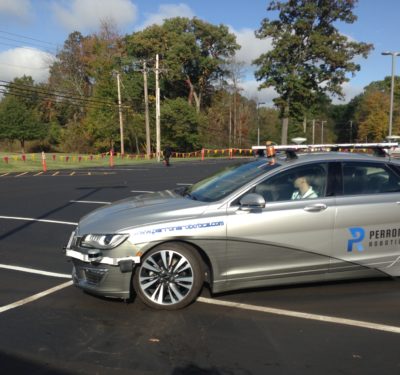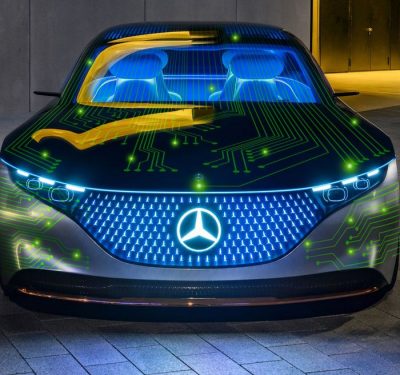
Flexible automation and artificial intelligence allow iterative planning, execution and learning from experiments in an autonomous loop.
New materials are required to address the urgent societal need for clean energy solutions (e.g., solar cells, batteries, CO2 utilization). The process of discovering and optimizing new materials takes many years, and slows the commercialization of new technologies. This article examines how flexible automation and artificial intelligence present an opportunity to break this bottleneck and shorten deployment timelines from decades to years.
Discovering a new useful material is challenging to do. All materials contain one or more ingredients. The choice of ingredients and their ratios determine the performance of the material. The performance of materials also depends on how the ingredients are combined. For example, combining carbon atoms at extreme temperature and pressure forms diamond, one of the hardest known materials. Under milder conditions, however, carbon atoms form graphite, a soft material used for pencils. As a result of the many possible ingredients and many possible ways they can be combined, there are billions of possible materials, the vast majority of which are not useful.
Finding a useful material is like finding a needle in a haystack. Materials scientists are therefore turning to automated experiments powered by artificial intelligence.
ACCELERATION OF MATERIALS DISCOVERY
Self-driving cars use AI and sensor data to efficiently navigate their environments. Similarly, materials scientists are now building self-driving laboratories that use AI and data from robotic experiments to efficiently navigate toward new, high-performance materials.
Self-driving laboratories combine flexible automation and artificial intelligence to iteratively plan, execute and learn from materials science experiments in an autonomous loop. A researcher initiates this loop by defining a goal, such as finding a material with high strength or electrical conductivity. The self-driving lab then begins synthesizing new materials. This task is performed by robots that combine ingredients in different ways. These robots then measure the performance of the resulting materials using scientific instruments such as microscopes and spectrometers.
Like an autonomous vehicle, a self-driving laboratory uses measurement data to build and continually update a model of its world. This model enables a self-driving lab’s AI to plan which experiment to do next to efficiently achieve its goal. This AI-driven experiment planning facilitates more efficient exploration of complex materials spaces than conventional methodologies. By iteratively learning from experiments in this way, self-driving laboratories accelerate the discovery of useful new materials.
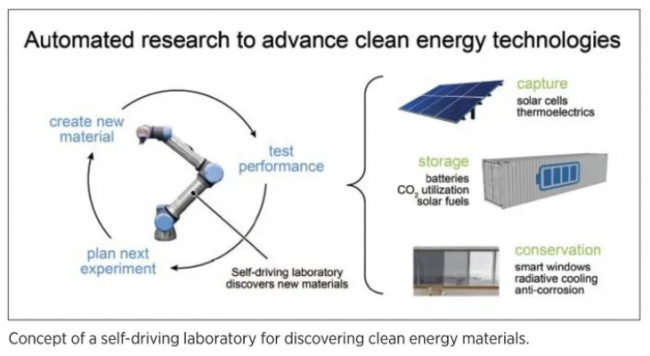
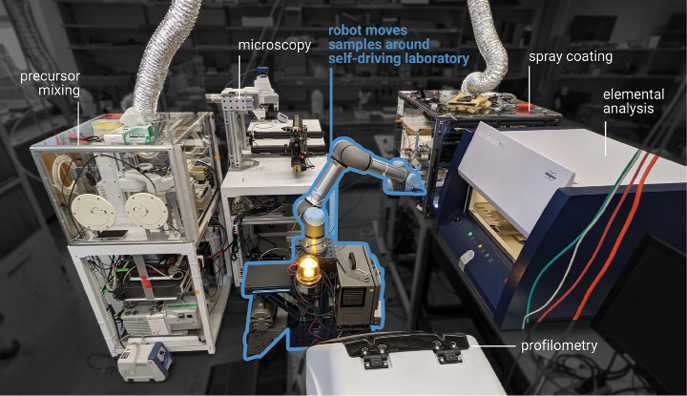
ADA: A SELF-DRIVING LABORATORY
The Berlinguette Group works on technologies that can reduce or reverse CO2 emissions. These include CO2 electrolyzers, next-generation solar cells, sustainable chemical manufacturing systems and fusion reactors. In each case, improved thin-film materials are needed to increase performance and decrease the cost of these technologies. To accelerate the discovery of these materials, we built the world’s first self-driving laboratory for thin films. We named this self-driving lab “Ada” in honor of Ada Lovelace, the world’s first computer programmer. She began algorithm development more than 150 years ago for an early mechanical computer. Her vision—that computers can do far more than simple calculations—inspires us to push the boundaries of computing by combining advanced robotics with artificial intelligence to make, test and learn from new materials on the fly.
Ada automatically performs materials science experiments using a new class of user-friendly collaborative robots. Unlike hazardous industrial robots, these collaborative robots have force limits that make them safe to use around people without extensive safety measures. The unique experimental procedures used in materials research often require specialized automation that is not commercially available. Collaborative robots empower materials scientists to automate these procedures. As a result, collaborative robots are proliferating in materials research, and self-driving laboratories are easier to build than ever before.
We designed Ada to automatically make and test new thin films and coatings. Ada studies these materials using a set of stations linked together by a collaborative six-axis robot arm. The experiment starts at the precursor mixing station. This station uses its own, smaller four-axis robot to carefully mix together different combinations of chemicals to form a precursor material. The six-axis robot arm then passes this precursor material to a robotic spray-coating station. The precursor is then coated onto a glass substrate. The properties of this coating are then modified using heat, ultraviolet light or chemicals. The final thin-film material is passed by the robotic arm to testing stations that measure properties like conductivity, roughness and reflectivity. Once Ada has made and characterized a material, the data gets added to a dataset that includes all the previous experiments. Ada’s AI uses this dataset to plan the next experiment.
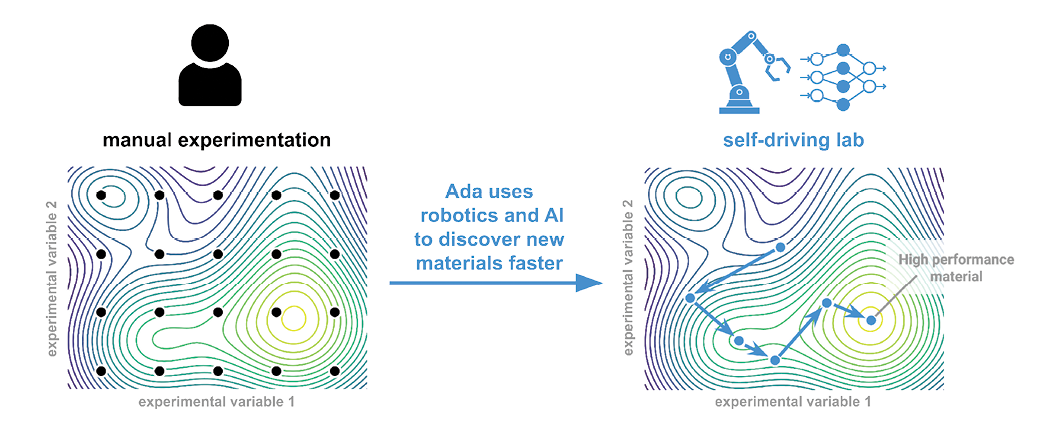
AI SUPPORTS DECISION-MAKING
Human experts make decisions based on mental models of the world. Ada, like many autonomous systems, uses a mathematical model to decide which action to take next. Ada does this using a technique known as Bayesian optimization. This iterative optimization technique involves two steps. In the first step, Ada builds a model of how the properties of the materials created by the robotic experiments respond to each experimental variable. In the second step, Ada uses this model to choose the experiment that maximizes the probability of discovering an improved material. Ada immediately starts performing this next experiment with no human intervention. Ada can perform up to 100 cycles of experimentation and decision-making per day. This iterative approach to experiment planning enables Ada to home in on high-performance materials faster than is possible with manual experiments, which tend to explore variables in a grid-search fashion. By closing the loop connecting material synthesis, testing and experiment planning, Ada accelerates the discovery and optimization of new materials.
We are using Ada to find useful materials faster than ever before. Our first demonstration of this self-driving laboratory identified the optimal balance of additives and heat treatment to make a solar cell material with improved electronic properties. Recently, we optimized the conductivity of metallic coatings. We are now using Ada to study electrocatalyst materials for creating fuels from thin air using carbon dioxide and renewable electricity.
AUTONOMY AND A MORE SUSTAINABLE FUTURE
Because the properties of a material depend on how it is processed, discoveries made at small scale in the laboratory do not always directly translate to larger-scale, real-world applications. For example, a corrosion-resistant coating that performs well in the lab on a small metal test coupon might undergo unexpected failures (e.g., cracking or peeling) when applied to a large vehicle. Ada’s ability to use spray coating is therefore a key feature because spray-coating is a large-scale coating technique already used in numerous industries (e.g., aerospace, automotive, fuel cells, glass manufacturing). We are also developing large automated cells to provide more realistic test conditions for the electrocatalyst materials synthesized by Ada. These tools will enable Ada to make industrially-relevant discoveries faster.
As with autonomous vehicles, improved AI algorithms are needed for self-driving labs. Many self-driving cars combine LiDAR, radar and images to reliably navigate their environments. The combination of multiple data types is also key to making self-driving laboratories more efficient and reliable. However, simply measuring multiple material properties is not enough. Like autonomous vehicles that must balance competing objectives such as safety and speed, materials are subject to multiple competing objectives (e.g., strength and weight). Because the ideal balance of properties for a material differs from application to application, we are employing state-of-the-art algorithms to efficiently map out the best possible tradeoffs between competing properties. We are also exploring the use of algorithms that more effectively handle real-world problems such as sensor noise. There are many improvements still to come in artificial intelligence for self-driving labs.
Self-driving laboratories harness AI and robotics to discover new materials faster than ever before. These low-cost, high-performance materials will power a growing array of clean energy technologies. While robotics are becoming easier to use, the materials science community still has much to learn about building autonomous systems. Collaborations between materials scientists and autonomous systems experts present an opportunity to drive toward a more sustainable future.


